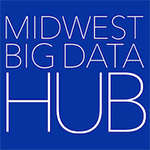The Midwest Big Data Innovation Hub is developing a community of data science student groups across the Midwest region to share their experiences and best practices. This story is part of a series of student group profiles.
For this profile, we spoke with leaders from DREAM, Data Resources for Eager & Analytical Minds, a recognized student organization at Minnesota State University, Mankato. It has over 300 student members who focus on data science, data analytics, machine learning, artificial intelligence, information technology, and computer science. DREAM organizes and hosts conferences, trainings, competitions, and industry talks to support the students’ academic and professional development. The DREAM members have won many awards at various data science competitions and have authored dozens of research papers and conference presentations. DREAM is a past recipient of the Outstanding RSO of the Year award.

What are the goals of your group, and who is your core audience?
DREAM was founded in 2016 when one dedicated data science professor at Minnesota State University, Mankato (MNSU), Dr. Rajeev Bukralia—the esteemed faculty advisor of DREAM—excited the students of the potential of and career opportunities in data science. Since the start, DREAM’s goal has been to explore, raise interest in, and share the wonders of data science and related fields. Our mission is to help students venture into the more interesting aspects of data science and corresponding fields, and in the process, connect students to industry mentors and professionals. We want to support anyone from any background who has interest in data analytics, data science, or computer science. Our core audience is varied because data itself is varied and can come from any field. Our audience is anyone who wants to understand that data on a deeper level, be they business majors, biology students, or just about anything else; we welcome anyone from any background who wants to participate!
What kinds of activities have you done previously, and what do you have planned for this year?
COVID has changed the format of our group considerably, but we still have regular industry talks and we act as a center for communicating events and opportunities to students interested in data science. Recently, we have had multiple industry leaders speak on their experiences working in the industry. They shared their experiences and tips to help set students up for success. So far this semester, we have hosted four industry talks with professionals from big companies such as UnitedHealth, One Drop, and Ovative. The larger projects we have planned for this semester focus around supporting students through the 2022 Data Derby Hackathon, setting up the spring election, and creating fun, themed training sessions for students to dip their toes into key tools for data science, such as Python and Power BI. We also hope to involve the members of our club in a student research showcase this spring in collaboration with MinneAnalytics.
As DREAM grows, we hope to expand our reach into the community. Through school or library programs, we hope to spark an interest in data science in kids grades 6 through 12. Programs like this would not only have to be volunteer-run, but also volunteer-created. So, after completing a few training sessions at the university, we hope to create an introductory data science curriculum that is interesting enough to captivate young students, but also approachable enough for young students.
What challenges have you faced in starting or maintaining your group?
The pandemic, of course, has been a large shift for a group like ours, which has over 300 students, dozens of which would be packed into a room eating pizza together on any given Thursday night pre-COVID. Since then, we have had to switch to Zoom for our meetings, although we’re trying to get back in person soon. There are also the general challenges of collaborating with university administration to secure and maintain the backend functions of the club and making sure to bring in a constant stream of new students to sustain the club.
What suggestions do you have for others who want to start a group on their campus, or expand their current group?
Reach out and promote your group through classes on your campus that are relevant—for example, we promote DREAM in the introductory data science courses and the database management courses.
Run events regularly—consistency will help build up more engagement, both from members of the group that are excited to participate more, or from members of the student body that just decide to pop into one meeting because they see it happening every week.
Keep a careful eye on your roster. Make sure you always have a copy backed up. Also, keep it organized so you can keep track of current students, alumni, etc. Your email roster is your direct point of contact with your group, so be sure to communicate with them regularly and to always maintain the current contact details.
Stay true to the mission. Be active and involved in community events. Try different methods to promote your group’s spirit and resources, such as Twitter and LinkedIn, etc.
Get involved
You can find the DREAM club on Twitter and their website.
Are you a student group leader or advisor? We’d like to hear more about your group’s activities. Contact us if you’d like us to profile your organization or participate in our student groups webinar series. You can also join our new Slack community to continue the discussion and make new connections.
About the Midwest Big Data Innovation Hub
The Midwest Big Data Innovation Hub is an NSF-funded partnership of the University of Illinois at Urbana-Champaign, Indiana University, Iowa State University, the University of Michigan, the University of Minnesota, and the University of North Dakota, and is focused on developing collaborations in the 12-state Midwest region. Learn more about the national NSF Big Data Hubs community.
